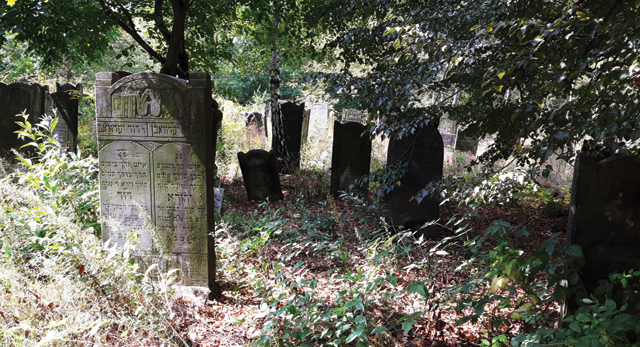STONE FOR MATZEVAH 1

In the previous issue of Kurier Kamienarski, we introduced the new Jewish cemetery in Łódź with the famous Mausoleum of Izrael and Eleonora Hertz Poznański, which is the largest Jewish grave monument in the world. In this issue we will once again visit the Łódź cemetery to discuss the Jewish funeral customs and the symbolism of tombstones.
We will start our expedition in the eastern part of the cemetery, where the largest funeral home in Poland is located. It was built at the end of the 19th century and was financed by philanthropist Mina Konstadt. The building was designed by architect Adolf Zelingson, who worked for the Poznański family.
The building was heavily damaged during World War II, but in 1987 the Nissenbaum Family Foundation financed its reconstruction. Today there is an exhibition of photographs of the cemetery, and in the main hall we can admire a 19thcentury hearse.
Funeral homes are also called purification homes, because according to Jewish tradition, at the moment of death a person becomes ritually unclean. Therefore the body must be ritually cleansed before the burial. The cleansing takes place in the so-called pre-funeral home, which is one of the cemetery facilities. In the Łódź cemetery the pre-funeral home can be accessed via a side gate.
The pre-funeral cleansing is traditionally performed by a burial society Chevra Kadisha. It used to be that members of Chevra Kadisha transported the deceased from their home (today this is usually done by the funeral home staff) and then performed a ritual cleansing of the body by washing it and dressing it in a simple white linen robe called tachrichim. Only then could the body be taken through the inner gate to the burial section of the cemetery. The deceased always had to be carried feet first. According to tradition, the funeral had to take place no longer than twenty-four hours after death, but today’s legislation does not allow for this rule to be observed.
As we have mentioned in the previous article, according to Jewish tradition men and women have to be buried separately. For this reason the cemetery is divided into the male and female sections. There are exceptions to this rule, as can be seen in the example of the Poznański family, where the husband and wife are buried together. Only the wealthiest could afford the magnificent and monumental tombs we can admire in the main part of the cemetery.
Most of the monuments in the cemetery are the so-called matzevahs. These are vertical tombstones resembling a gate that symbolise the transition from this to the other world. Matzevahs can be made of various materials, but are usually made of stone. What is interesting is that the tombstone is erected on the cemetery on the anniversary of the person’s death. On the day of the funeral the grave is simply filled with soil.
Apart from matzevahs we can also see other types of monuments in the cemetery. The remains of wealthy people are often laid in sarcophagi. One such example in the Łódź cemetery is Isaac Herz’s sarcophagus made of red sandstone. Another way of storing the remains are the so-called ohelim. These are small whitewashed buildings with graves of leading members of the Jewish community, most often rabbis or tzadiks.
In accordance with Jewish tradition, there are no depictions or photographs of the dead on Jewish tombstones. On the upper part of matzevah there is usually an inscription providing important information about the deceased.
Source: Kurier kamieniarski
Author: Jakub Zdańkowski | Published: 14 May 2019
